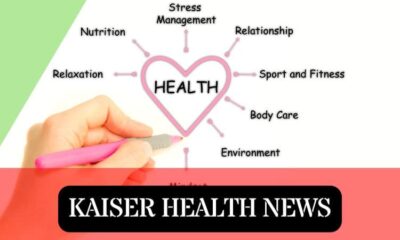Kaiser Health News
As Colorado Reels From Another School Shooting, Study Finds 1 in 4 Teens Have Quick Access to Guns
by Markian Hawryluk
Mon, 27 Mar 2023 15:05:00 +0000
One in 4 Colorado teens reported they could get access to a loaded gun within 24 hours, according to survey results published Monday. Nearly half of those teens said it would take them less than 10 minutes.
“That’s a lot of access and those are short periods of time,” said Virginia McCarthy, a doctoral candidate at the Colorado School of Public Health and the lead author of the research letter describing the findings in the medical journal JAMA Pediatrics.
The results come as Coloradans are reeling from yet another school shooting. On March 22, a 17-year-old student shot and wounded two school administrators at East High School in Denver. Police later found his body in a nearby park and confirmed he had died from a self-inflicted gunshot wound. Another East High student was fatally shot in February while sitting in his car outside the school.
The time it takes to access a gun matters, McCarthy said, particularly for suicide attempts, which are often impulsive decisions for teens. In research studying people who have attempted suicide, nearly half said the time between ideation and action was less than 10 minutes. Creating barriers to easy access, such as locking up guns and storing them unloaded, extends the time before someone can act on an impulse, and increases the likelihood that they will change their mind or that someone will intervene.
“The hope is to understand access in such a way that we can increase that time and keep kids as safe as possible,” McCarthy said.
The data McCarthy used comes from the Healthy Kids Colorado Study, a survey conducted every two years with a random sampling of 41,000 students in middle and high school. The 2021 survey asked, “How long would it take you to get and be ready to fire a loaded gun without a parent’s permission?”
American Indian students in Colorado reported the greatest access to a loaded gun, at 39%, including 18% saying they could get one within 10 minutes, compared with 12% of everybody surveyed. American Indian and Native Alaskan youths also have the highest rates of suicide.
Nearly 40% of students in rural areas reported having access to firearms, compared with 29% of city residents.
The findings were released at a particularly tense moment in youth gun violence in Colorado. Earlier this month, hundreds of students left their classrooms and walked nearly 2 miles to the state Capitol to advocate for gun legislation and safer schools. The students returned to confront lawmakers again last week in the aftermath of the March 22 high school shooting.
The state legislature is considering a handful of bills to prevent gun violence, including raising the minimum age to purchase or possess a gun to 21; establishing a three-day waiting period for gun purchases; limiting legal protections for gun manufacturers and sellers; and expanding the pool of who can file for extreme risk protection orders to have guns removed from people deemed a threat to themselves or others.
According to the federal Centers for Disease Control and Prevention, firearms became the leading cause of death among those ages 19 or younger in 2020, supplanting motor vehicle deaths. And firearm deaths among children increased during the pandemic, with an average of seven children a day dying because of a firearm incident in 2021.
Colorado has endured a string of school shootings over the past 25 years, including at Columbine High School in 1999, Platte Canyon High School in 2006, Arapahoe High School in 2013, and the STEM School Highlands Ranch in 2019.
Although school shootings receive more attention, the majority of teen gun deaths are suicides.
“Youth suicide is starting to become a bigger problem than it ever has been,” said Dr. Paul Nestadt, a researcher at the Johns Hopkins Center for Gun Violence Solutions.
“Part of that has to do with the fact that there’s more and more guns that are accessible to youth.”
While gun ownership poses a higher risk of suicide among all age groups, teens are particularly vulnerable, because their brains typically are still developing impulse control.
“A teen may be bright and know how to properly handle a firearm, but that same teen in a moment of desperation may act impulsively without thinking through the consequences,” said Dr. Shayla Sullivant, a child and adolescent psychiatrist at Children’s Mercy Kansas City. “The decision-making centers of the brain are not fully online until adulthood.”
Previous research has shown a disconnect between parents and their children about access to guns in their homes. A 2021 study found that 70% of parents who own firearms said their children could not get their hands on the guns kept at home. But 41% of kids from those same families said they could get to those guns within two hours.
“Making the guns inaccessible doesn’t just mean locking them. It means making sure the kid doesn’t know where the keys are or can’t guess the combination,” said Catherine Barber, a senior researcher at the Harvard University T.H. Chan School of Public Health’s Injury Control Research Center, who was not involved in the study. “Parents can forget how easily their kids can guess the combination or watch them input the numbers or notice where the keys are kept.”
If teens have their own guns for hunting or sport, those, too, should be kept under parental control when the guns are not actively being used, she said.
The Colorado researchers now plan to dig further to find out where teens are accessing guns in hopes of tailoring prevention strategies to different groups of students.
“Contextualizing these data a little bit further will help us better understand types of education and prevention that can be done,” McCarthy said.
KHN (Kaiser Health News) is a national newsroom that produces in-depth journalism about health issues. Together with Policy Analysis and Polling, KHN is one of the three major operating programs at KFF (Kaiser Family Foundation). KFF is an endowed nonprofit organization providing information on health issues to the nation.
USE OUR CONTENT
This story can be republished for free (details).
By: Markian Hawryluk
Title: As Colorado Reels From Another School Shooting, Study Finds 1 in 4 Teens Have Quick Access to Guns
Sourced From: khn.org/news/article/east-high-school-colorado-shooting-youth-gun-violence-study/
Published Date: Mon, 27 Mar 2023 15:05:00 +0000
Kaiser Health News
Readers Embrace ‘Going It Alone’ Series on Aging and Chastise Makers of Pulse Oximeters
SUMMARY: Letters to the Editor discuss various healthcare concerns. Gail Daniels shares her struggles caring for a mother with dementia, while Shava Nerad reflects on the challenges faced by those without family support. Gloria Rankin suggests using pen pals to combat social isolation. Zoe Joyner Danielson recalls racial bias in pulse oximeter development, while Suzann Lebda questions fluoride’s impact on dental health. Readers also address issues like Medicare Advantage, high drug costs for seniors, and the financial burden of prepaying for baby deliveries. Liviu Steier advocates for fluorescence in dental care, emphasizing its diagnostic benefits.
The post Readers Embrace ‘Going It Alone’ Series on Aging and Chastise Makers of Pulse Oximeters appeared first on kffhealthnews.org
Kaiser Health News
Georgians With Disabilities Are Still Being Institutionalized, Despite Federal Oversight
SUMMARY: Lloyd Mills, a 32-year-old with autism, cerebral palsy, and kidney disease, has faced prolonged hospitalization due to inadequate community support in Georgia. After being admitted to Grady Memorial Hospital for mental health issues, Mills waited over eight months for appropriate housing, highlighting the systemic failures of a state still grappling with the consequences of a 2010 Department of Justice lawsuit regarding care for people with developmental disabilities. Despite significant investments and improvements in services, challenges like workforce shortages and inadequate funding persist, often leaving individuals like Mills in hospitals, impacting their mental and physical well-being.
The post Georgians With Disabilities Are Still Being Institutionalized, Despite Federal Oversight appeared first on kffhealthnews.org
Kaiser Health News
TV’s Dr. Oz Invested in Businesses Regulated by Agency Trump Wants Him To Lead
SUMMARY: President-elect Donald Trump nominated celebrity doctor Mehmet Oz to head the Centers for Medicare & Medicaid Services (CMS). Oz, known for his investments in healthcare, tech, and food companies, holds significant stakes in UnitedHealth Group, CVS Health, Amazon, and other companies involved in health insurance and pharmaceuticals, raising potential conflicts of interest. His financial ties include hospital stocks and pharmaceutical investments. Oz has expressed support for Medicare Advantage and criticized the food and healthcare industries. Critics question whether Oz can separate his financial interests from his role, particularly with companies doing business with the federal government.
The post TV’s Dr. Oz Invested in Businesses Regulated by Agency Trump Wants Him To Lead appeared first on kffhealthnews.org
-

 Local News6 days ago
Local News6 days agoCelebrate the holidays in Ocean Springs with free, festive activities for the family
-

 News from the South - Georgia News Feed7 days ago
News from the South - Georgia News Feed7 days ago'Hunting for females' | First day of trial in Laken Riley murder reveals evidence not seen yet
-

 News from the South - Alabama News Feed7 days ago
News from the South - Alabama News Feed7 days agoFirst woman installed as commanding officer of NAS Pensacola
-

 Kaiser Health News4 days ago
Kaiser Health News4 days agoA Closely Watched Trial Over Idaho’s Near-Total Abortion Ban Continues Tuesday
-

 Mississippi Today6 days ago
Mississippi Today6 days agoOn this day in 1972
-

 News from the South - Alabama News Feed3 days ago
News from the South - Alabama News Feed3 days agoTrial underway for Sheila Agee, the mother accused in deadly Home Depot shooting
-

 News from the South - Georgia News Feed2 days ago
News from the South - Georgia News Feed2 days agoJose Ibarra found guilty in murder of Laken Riley | FOX 5 News
-

 News from the South - Alabama News Feed3 days ago
News from the South - Alabama News Feed3 days agoAlabama's weather forecast is getting colder, and a widespread frost and freeze is likely by the …































